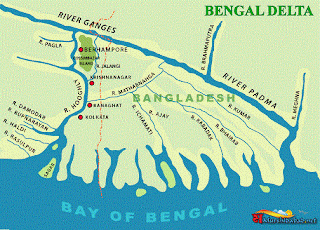 |
| Ganges delta |
We mentioned each contributor's field of study because, well, not a one of them was germane to the topic; which would naturally fall under either geography or physical geology. Oops.
As is often the case with Leaf's rewrite specialists. Peterson took what McAdams had written and expanded upon it, including a retelling of the Herodotus story covered in Claire's introduction:
"In the fifth century B.C., Herodotus used the term to describe the Nile Delta in Egypt, as it had a similar triangular shape to the Greek letter delta."
Neither McAdams nor Peterson (or, for that matter, Tremblay) seemed to realize that the Greek letter delta looks like this: δ (unless it's the capital version). Duh. You may say that's a quibble; so be it. The rest of Peterson's goofs aren't quibbles...
- "Delta land forms are created at or near the mouths of rivers..." – We're hard-pressed to think of a delta that's only "near" the river mouth.
- "Erosional landforms of rivers, deltas are caused by sediment..." – Deltas are not "erosional landforms"; they are depositional landforms.
- "Common in small lakes..." – Ummm, no, they're not.
- "Alluvial sediment is a term for material... that is deposited on a land form by water action." – "[D]eposited on a land form"? the landform (it's one word, not two) consists of alluvium. Better phrasing would be "deposited as a landform."
- "...the water body that the sediment is deposited in must be calm, or the sediment will be carried away from the mouth of the river or stream quickly. Alluvial sediment is particularly abundant in the runoff from a flood." – Here, Peterson (and Tremblay) demonstrate their ignorance of the interplay between sediment supply and the energy of the water body. Try googling "wave-dominated delta," John and Sylvie (like McAdams did!). And, FWIW, those two sentences comprise a rather disjoint paragraph.
- "When the sediment is excessive, such as during flooding episodes, the material will clog the flow of water and eventually create accumulation, which will become a delta over the course of time." – Apparently hung up on the Nile Delta, John seemed to think that deposition occurs only during floods. Sorry, John, but that's bullshit.
- "Major deltas are formed at the mouths of the world's largest rivers, such as the Yellow River in China, the Nile in Egypt, the Amazon in South America and the Mississippi River in the United States." – While true, John didn't seem aware that the world's largest delta is that of the Ganges system (see above)...
Not content with sharing misinformation about deltas, Peterson also thought he'd share something about another fluvial deposit with a similar shape:
"Alluvial fans are a form of delta where the alluvial sediment is deposited onto level land or a plain."
Dude, a plain is "level land"! The more important feature of alluvial fans is that they are subaerial deposits found at the mouths of canyons where there is a large change in slope. Duh: no wonder you're collecting a Dumbass of the Day award!
SI - GEOMORPHOLOGY
No comments:
Post a Comment